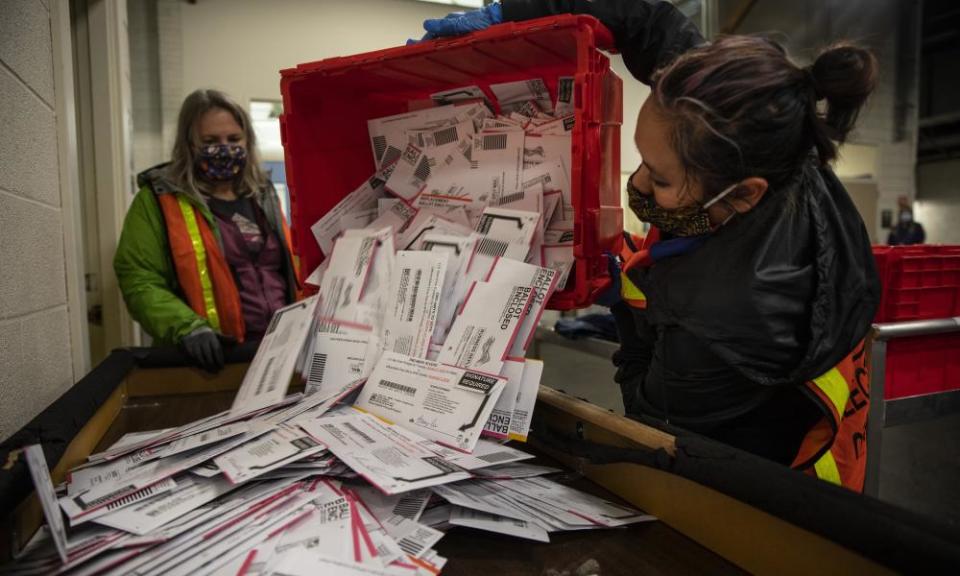Mail-in voting did not raise turnout or boost Democrats, study finds

Mail-in voting did not significantly increase turnout nor did it benefit Democrats in the 2020 election, a new study has found, undermining the talking point, advanced by Donald Trump and others, that mail-in ballots cost him the election.
Related: Fight to vote: This is how Georgia Republicans are attacking democracy
States that required an excuse to vote by mail saw increases in turnout similar to those that did not, the researchers from Stanford found. In Texas, where only voters ages 65 and up can vote by mail without an excuse, Democratic turnout did not “substantially increase” relative to Republican turnout.
“Despite the extraordinary circumstances of the 2020 election, vote-by-mail’s effect on turnout and on partisan outcomes is very muted,” the researchers wrote. “Voter interest appears to be far more important in driving turnout.”
Those findings challenge the conventional wisdom that has emerged after Joe Biden’s victory in November. Republicans have repeatedly pointed to the decision to expand vote by mail – a choice driven largely by the Covid-19 pandemic – as a major reason Trump lost the election. They have filed a flood of bills in statehouses seeking to restrict voting, several of which take aim at mail-in voting specifically. In Georgia, for example, there are proposals to require voters to provide identification information as well as an excuse when they vote absentee, which would end the no-excuse policy Republicans adopted there in 2005.
The Stanford findings also come amid an effort by Democrats in Congress to push nationwide changes that would require states to offer no-excuse balloting nationwide. Republicans staunchly opposed that effort, saying it is part of a broader set of reforms to help Democrats’ political prospects.
“The results of our paper do not offer a clear recommendation for the policy debate around vote-by-mail, but they do suggest that both sides of the debate are relying on flawed logic,” the study says. “Vote-by-mail is an important policy that voters seem to like using, and it may be a particularly important tool during the pandemic.”
Overall, states that adopted no-excuse absentee voting in 2020 saw around a 5.6 percentage-point increase in turnout compared to 2016. States that still required an excuse saw a 4.8-point increase. The researchers were unconvinced that the modest difference in turnout represented an even minor bump in turnout because of vote-by-mail, noting there was random variation in turnout between elections.
To better understand the effects of mail-in voting, the researchers focused on Texas, where they compared turnout among 65-year-olds able to vote without an excuse under state law to that of 64-year-olds, who still needed an excuse. When they did the comparison, they found “no noticeable increase” in turnout among the 65-year-olds who did not have to provide an excuse to vote by mail.
They reached a similar conclusion when they looked at partisanship in Texas. Sixty-five-year-old Democrats embraced absentee voting in 2020 while Republicans continued to vote early in person. Overall, being able to vote easily by mail did not produce “large effects on the partisan composition of overall turnout in 2020”.
Michael McDonald, a professor at the University of Florida who closely tracks voter turnout, said there were factors not discussed in the study that were important to consider when assessing turnout. Some of the biggest increases in turnout from 2016 to 2020 were in states where voters automatically receive a ballot, he said. Several of the states where there was no-excuse absentee voting also still had a wide range of hurdles – like showing photo ID or getting a notary signature – that could make it harder to cast a ballot.
“Mail ballot usage is a better way to examine the effect of laws and policies than simply whether or not a state had a particular policy, since there are often many policies that affect mail ballot usage, such as all-mail ballot elections, ID requirements, dropbox accessibility, return deadlines, etc,” he said.
Previewing the release of our 2020 #AmericaGoesToThePolls report on Thursday, March 11, all-mail ballot states had a greater increase in turnout compared to 2016 than states that either required a non-COVID excuse or had a id/notary requirement to cast a mail ballot https://t.co/JYyphRMwAP pic.twitter.com/GVr7VEX919
— Michael McDonald (@ElectProject) March 5, 2021
Even if mail-in voting did not ultimately boost Democrats, officials told the Guardian last year that the process made it easier to target, track and encourage voters to cast a ballot. Jay Tucker, the chair of the Democratic committee in Pike county, Pennsylvania, said it was useful for the party to be able to see who had requested a ballot and had yet to return it during the election. Those efforts, he said, helped cut into Trump’s margins in the county.
While the researchers found mail-in voting did not have a major effect on turnout in 2020, they noted that it could be more consequential in contests where interest is typically lower, like a midterm.
“When voter interest is high, such as in 2020, even low-propensity voters … could base their decision to vote on the convenience of doing so, turn out at the same rate whether or not they can take advantage of no-excuse absentee voting,” they wrote.
“When voter interest is low, there is likely to be more room for altering the costs of voting to affect turnout.”

 Yahoo Finance
Yahoo Finance 